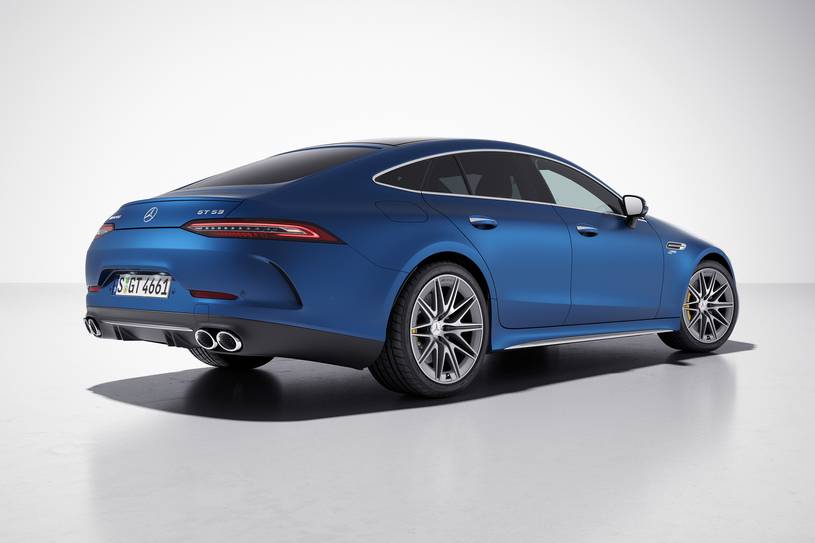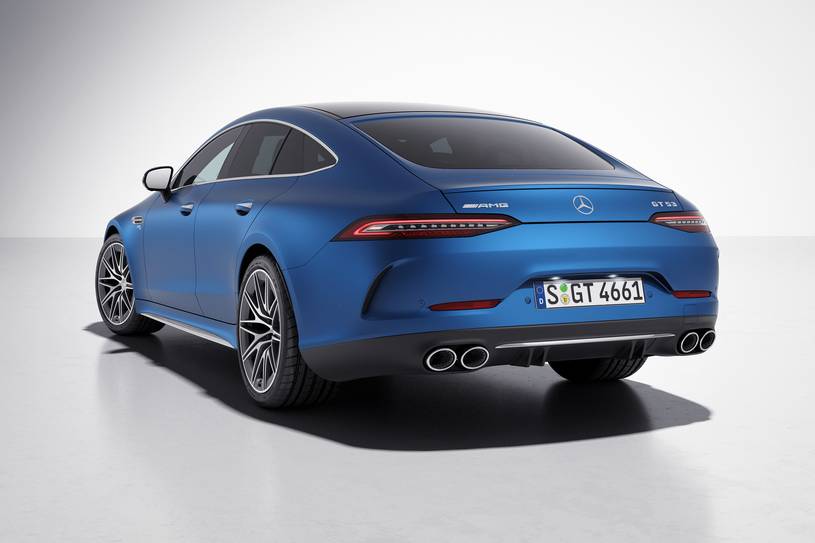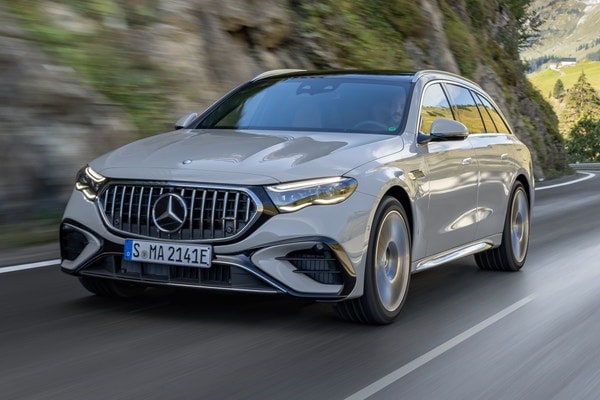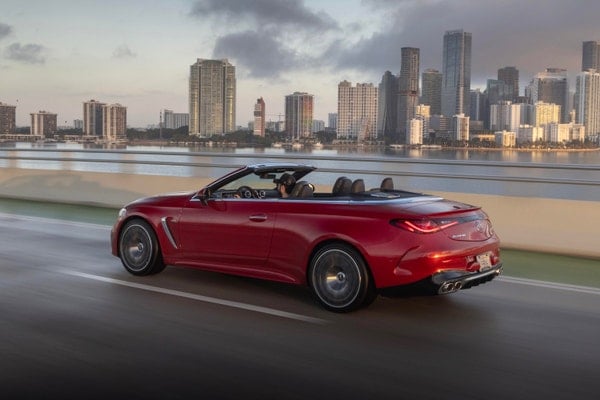For years, reducing tailpipe emissions and improving fuel economy were the main goals of cars with hybrid powertrains. Performance boosts granted by adding a small electric motor were minimal, but the potential has always been there. That leads us to the new 2025 Mercedes-AMG GT 63 S E Performance, a car with a long name and a very long set of legs.
What's under the AMG GT's hood?
Like the AMG GT 55 and GT 63 coupes, the GT 63 S E Performance is powered by a 4.0-liter turbocharged V8. Alone, the V8 makes 603 horsepower and 627 lb-ft of torque. For reference, the GT 55 makes 469 hp and 516 lb-ft, while the GT 63 makes 577 hp and 590 lb-ft. None of those figures are anything to scoff at, but they pale compared to the E Peformance's total output.
An electric motor at the rear axle combines with the V8 for a total system output of 805 horsepower and 1,047 lb-ft in the GT 63 S E Performance, more than double the torque output of the GT 55 and on par with the Tesla Model S Plaid. The electric motor gets its juice from a small 4.8-kWh battery pack that, when charged, allows for a small amount of all-electric driving.
The V8's power is sent to all four wheels through a nine-speed automatic transmission. With sticky Michelin Pilot Sport S 5 tires managing all that power, Mercedes says the GT 63 S E Performance can accelerate from 0 to 60 mph in a scant 2.7 seconds. That makes this coupe the quickest-accelerating production car AMG has ever produced.
The hybrid components of the powertrain are mostly there for performance, but it's not all about speed and power. That 4.8-kWh hybrid battery allows for a short amount of all-electric driving. And we do mean short. Mercedes hasn't announced EPA ratings for the E Performance, but expect less than 10 miles of all-electric driving. That's far shorter than the range in the Mercedes-AMG S 63 E Performance, though that big sedan isn't nearly as quick as this coupe.
What's the new AMG GT Pro like?
The GT 63 S E Performance is aimed at on-road performance, but AMG hasn't forgotten about drivers who like to take their cars to the track. The Pro is an optimized version of the non-hybrid GT 63 S. The Pro's suspension has not been changed compared to that car, and changes to the engine are relatively minor. The car's V8 output is the same as the E-Performance's output (sans hybrid of course) at 603 hp and 627 lb-ft.
Mercedes' focus for the Pro is weight loss. That's good, as this is not a lightweight car. A GT 63 we recently tested against a BMW M8 measured nearly 4,300 pounds on our scales. While the Pro is the lightest version of the current AMG GT, it's still several hundred pounds heavier than any version of the past AMG GT. For reference, a 2018 AMG GT R weighed 3,665 pounds, more than 600 pounds lighter than the Pro.
The Pro's forged 21-inch wheels are lighter than those on the standard car and weigh about 24 pounds per corner. AMG says these are the lightest wheels it makes. The carbon-ceramic brakes have six-piston fixed front calipers with 16.5-inch rotors and single-piston rear calipers with 14.2-inch rotors. The fronts are the largest brakes available on any AMG. Michelin Pilot Sport 5 S tires are standard, but the car I drove had grippier Pilot Sport Cup 2 R tires, a no-cost option.
There's a new front apron and bigger ducts in the front bumper to improve cooling. There's additional aero work under the body. AMG says the Pro's front lift has decreased and rear downforce has increased compared to the GT 63 S. While the additional aero and cooling tacked on some weight, savings elsewhere make the Pro about 44 pounds lighter than the GT 63 S.
How does the AMG GT 63 S E Performance drive?
The acceleration delivered by the GT is nearly unparalleled on the road, with only the highest-caliber performance cars able to match or exceed it. There's never a point at which the car feels short of power or out of breath. We had a few opportunities to open things up on Germany's unrestricted autobahn, one of the few stretches of pavement where it's really possible to exploit the car's power. It takes little effort or time to get to triple-digit speeds, and with a long enough stretch of open air, the E Performance will top out at an electronically limited 199 mph.
On winding country roads near AMG's headquarters in Affalterbach, the GT feels immense and unflappable. Passing slower motorists (e.g., farm tractors and the occasional Renault Twingo driver) requires little more than a small dip of the throttle. In Comfort, the transmission takes a second to downshift, but in any of the more dynamic modes (Sport, Sport+ and Race) the transmission drops a gear with little hesitation. Just point the wheel and hold on.
What about the handling?
The powertrain might garner most of the attention, but the GT's handling prowess shouldn't be overlooked. Standard features include carbon-ceramic brakes, an adaptive suspension, active anti-roll bars and rear-axle steering. The car corners well on winding back roads. There's only a mild amount of roll in corners, but the car still feels a bit big and heavy. It doesn't shrink around you like a Porsche 911 Turbo S or McLaren Artura. Mercedes isn't saying how much the AMG GT 63 S E Performance weighs. We asked and the PR reps wouldn't tell us.
The all-wheel-drive system and Michelin tires provide plenty of traction, aided by the rear-axle steering system. Below 60 mph, the rear wheels turn the opposite direction of the front for tighter turn-in. Above 60 mph, the rear wheels turn with the front for improved high-speed stability. It's subtle and feels more natural than some past rear-axle steering systems, though it's mostly helpful at speed. Parking the AMG GT requires a few moves as the turning radius is still quite large.
A rotary knob on the steering wheel will allow you to swap between various drive modes. There are the typical performance modes that increase throttle sensitivity, sharpen up and downshifts, stiffen the suspension, and adjust stability control, but there are also modes that will force the car to run solely on electricity or hold the battery's charge for later use. The GT packs a truly great-sounding V8, but it's also nice being able to roll out of your driveway in the morning without waking all of the neighbors. The residents in the villages along our drive route probably appreciated the quiet nature too.
While the E Performance is focused on being a great sports car for the street, the new AMG GT 63 Pro is all about on-track performance. It's the lightest AMG GT around, though it's still hundreds of pounds heavier than the last model. All-wheel drive and a well-tuned suspension make it a very capable car on track, though we wish it felt as light and nimble as the past AMG GT.
How comfortable is the AMG GT 63 S E Performance?
Ride comfort, even with the adaptive suspension, is on the firm side of comfortable. While it never punishes, even in the sportiest setting, you always feel some of the road surface. Germany's roads are generally excellent, especially compared to the streets around Edmunds' Southern California headquarters. There's not as much compliance in the suspension as in the GT's twin, the Mercedes-AMG SL. The SL and GT are built on the same platform these days, and AMG tunes the SL more for comfort and touring and the GT more for sport and performance.
How is the interior?
The GT's cabin looks great and is very well appointed, though it's essentially the same as the one in the non-E Performance coupe. The seats offer plenty of adjustment for things like bolstering and lumbar, so most people should be able to find a comfortable position with a bit of fine-tuning. The seats are sufficiently bolstered to keep you in place and have soft and plush padding; we never felt stiff after a full day behind the wheel. The GT comes standard with two seats, though a rear seat is available as a no-cost option. It's tight back there. Very tight, even for children, so you might be better off skipping the seat entirely and using the parcel shelf that comes standard.
And you'll need that parcel shelf. Despite being minuscule by the standards of a hybrid or EV, the E Performance's battery still takes up a sizable amount of space in the hatch. The regular AMG GT coupe already has a huge cargo area for a coupe, so the cargo area isn't totally compromised when the battery from the E Performance is shoved back there, but it's worth keeping in mind.
Storage in the rest of the cabin is much better but still limited, with a decently sized center console and glovebox but smallish door pockets and cupholders that are a bit too closely spaced.
Competitors to consider
It's hard to name a direct competitor for the AMG GT 63 S E Performance as there are few plug-in hybrid performance cars. The McLaren Artura fits the bill more closely than most as it, too, features a plug-in hybrid powertrain. McLaren's V6 isn't as powerful as AMG's V8, and the mid-engine layout gives it a different character in both handling and design. It's a little more exotic, but it's not as quick or as spacious as the AMG.
If you're willing to go without the hybrid powertrain, the Porsche 911 Turbo S offers similar performance at a similar price point. Like the McLaren, the engine placement (in this case behind the rear axle) gives the 911 a different look and feel from the Mercedes.











